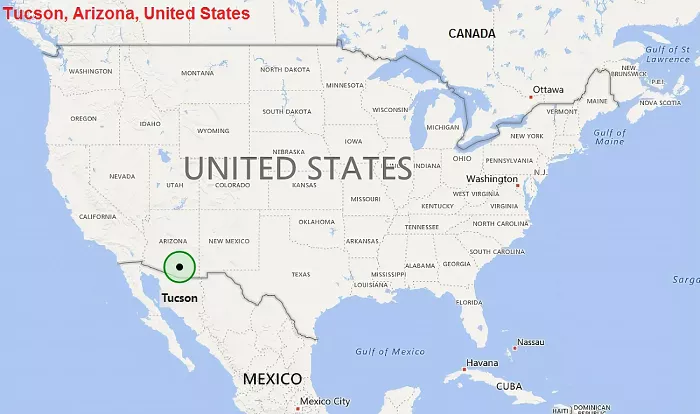Tucson, Arizona, is a vibrant city rich in history, culture, and natural beauty. Nestled in the Sonoran Desert, it offers a unique blend of urban amenities and scenic landscapes. This article provides a detailed overview of Tucson’s location, geography, history, and attractions, offering readers a comprehensive understanding of this southwestern gem.
Geographic Location
Tucson is located in the southeastern part of Arizona, approximately 115 miles southeast of Phoenix. The city lies along the Santa Cruz River on a hilly plain of the Sonoran Desert, rimmed by the Santa Catalina and other mountain ranges. It sits at an elevation of 2,410 feet (735 meters) and covers nearly 500 square miles.
The city’s geographic coordinates are approximately 32.2226° N latitude and 110.9747° W longitude. Tucson is surrounded by five unique mountain ranges: the Santa Catalina Mountains to the north, the Rincon Mountains to the east, the Santa Rita Mountains to the south, the Tucson Mountains to the west, and the Tortolita Mountains to the northwest. This diverse topography contributes to Tucson’s varied landscape, which includes flowering deserts, rolling hills, winding dry riverbeds, rugged canyons, and pine-topped peaks.
Accessing Tucson
Tucson is accessible via several major highways:
- Interstate 10 (I-10): Runs east-west, connecting Tucson to Phoenix to the northwest and Las Cruces, New Mexico, to the east.
- Interstate 19 (I-19): Extends southward from Tucson to Nogales, Arizona, near the U.S.-Mexico border.
- State Route 77 (SR 77): Leads northward to the town of Oracle and further to Globe, Arizona.
- State Route 86 (SR 86): Heads west toward Ajo, Arizona, and the Organ Pipe Cactus National Monument.
The city is also served by the Tucson International Airport (TUS), located about 8 miles south of downtown, offering flights to various domestic and limited international destinations.
Historical Background
Tucson’s history is rich and diverse, reflecting a tapestry of cultures and influences over thousands of years.
Early Inhabitants
The Tucson area has been inhabited for over 4,000 years, making it one of the oldest continuously inhabited regions in North America. The Hohokam people, known for their sophisticated irrigation canals, were among the early inhabitants.
Spanish and Mexican Periods
In 1692, Jesuit missionary Eusebio Francisco Kino visited the area and established the Mission San Xavier del Bac, which still stands today as a significant cultural and historical landmark. Tucson officially became a part of the Spanish Empire in 1775 with the construction of Presidio San Agustín del Tucsón, a military fort designed to protect against Apache raids. Following Mexico’s independence from Spain in 1821, Tucson became part of Mexico.
American Incorporation
The Gadsden Purchase of 1854 transferred Tucson and much of southern Arizona to the United States. Tucson served as the territorial capital of Arizona from 1867 to 1877. The arrival of the Southern Pacific Railroad in 1880 spurred economic growth and population expansion, establishing Tucson as a vital transportation hub.
Climate
Tucson experiences a desert climate characterized by hot summers and mild winters. Average high temperatures in the summer months often exceed 100°F (38°C), while winter temperatures are typically mild, with daytime highs averaging around 65°F (18°C). The region receives about 12 inches of rainfall annually, primarily during the North American Monsoon season, which occurs from June to September.
Natural Attractions
Tucson’s natural surroundings offer a plethora of outdoor recreational opportunities:
Saguaro National Park
Split into two districts flanking the city to the east and west, Saguaro National Park is home to the nation’s largest cacti, the giant saguaro, a symbol of the American West. Visitors can enjoy scenic drives, hiking trails, and interpretive programs that showcase the unique desert ecosystem.
Mount Lemmon
Part of the Santa Catalina Mountains, Mount Lemmon stands at 9,157 feet and offers a cool retreat from the desert heat. Accessible via the Catalina Highway, the mountain features hiking trails, campgrounds, and the southernmost ski area in the United States.
Sabino Canyon
Located in the Coronado National Forest, Sabino Canyon is a popular destination for hiking, birdwatching, and picnicking. The canyon’s trails wind through stunning desert landscapes, and a shuttle service is available for those seeking a more leisurely experience.
Cultural and Historical Attractions
Tucson’s rich cultural heritage is reflected in its numerous museums, historic sites, and vibrant arts scene:
Mission San Xavier del Bac
Known as the “White Dove of the Desert,” this historic Spanish Catholic mission is an architectural masterpiece showcasing Moorish, Byzantine, and late Mexican Renaissance styles. It remains an active parish and is open to visitors year-round.
Arizona-Sonora Desert Museum
This renowned indoor-outdoor museum combines elements of a zoo, botanical garden, art gallery, natural history museum, and aquarium. It offers an in-depth look at the flora and fauna of the Sonoran Desert region.
Pima Air & Space Museum
One of the world’s largest aerospace museums, it features over 350 aircraft and spacecraft, including historic military planes, commercial aircraft, and unique prototypes.
Conclusion
Tucson, Arizona, is a vibrant and culturally rich city located in the heart of the Sonoran Desert. Its unique location, surrounded by mountain ranges and desert landscapes, makes it a stunning destination for outdoor enthusiasts and history buffs alike. Whether you’re exploring the iconic saguaro cacti, visiting historic missions, or enjoying the city’s vibrant arts scene, Tucson offers something for everyone.
Next time you look at a map of Arizona, you’ll know exactly where to find this iconic city. From its geographic coordinates to its cultural landmarks, Tucson is a fascinating destination that captures the spirit of the American Southwest.

